The Influence of the Antarctic Oscillation (AAO) on Cold Waves and Occurrence of Frosts in the State of Santa Catarina, Brazil
Abstract
:1. Introduction
2. Materials and Methods
3. Results
3.1. Statistical Analysis between Cold Waves and the AAO
3.2. Statistical Analysis between Frosts and the AAO
4. Discussion and Conclusions
Acknowledgments
Author Contributions
Conflicts of Interest
References
- Grimm, A.M. Variabilidade Interanual do Clima no Brasil. In Tempo e Clima no Brasil, 1st ed.; Cavalcanti, I.F.A., Ed.; Oficina de texto: São Paulo, Brasil, 2009; Volume 1, pp. 353–373. [Google Scholar]
- Monteiro, M. Caracterização climática do estado de Santa Catarina: Uma abordagem dos principais sistemas atmosféricos que atuam durante o ano. Rev. Geosul. 2001, 16, 69–78. [Google Scholar]
- Murara, P.G.; Fuentes, M.V. Neve. In Atlas de Desastres Naturais do Estado de Santa Catarina: Período de 1980 a 2010, 2nd ed.; Cavalcanti, I.F.A., Ed.; IHGSC-GCN/UFSC: Florianópolis, Brasil, 2014; Volume 1, pp. 163–166. [Google Scholar]
- Monteiro, M.; Mendonça, M. Dinâmica Atmosférica no Estado de Santa Catarina. In Atlas de Desastres Naturais do Estado de Santa Catarina: Período de 1980 a 2010, 2nd ed.; Cavalcanti, I.F.A., Ed.; IHGSC-GCN/UFSC: Florianópolis, Brasil, 2014; Volume 1, pp. 5–12. [Google Scholar]
- Mendonça, M.; Romero, H. Ondas de frio, índices de oscilação e impactos socioambientais das variabilidades climáticas de baixa frequência na América do Sul. Rev. Acta Geogr. 2012, 2, 185–203. [Google Scholar] [CrossRef]
- BRASIL. Ministério da Saúde. Exposição ao frio Pode Agravar Doenças Respiratórias. Portal Brasil/Portal da Saúde, 2014. Available online: http://www.brasil.gov.br/saude/2014/04/exposicao-ao-frio-pode-agravar-doencas-respiratorias (accessed on 24 November 2016). [Google Scholar]
- Boyle, J.S. Comparison of the synoptic conditions in midlatitudes accompanying cold surges over eastern Asia for the months of December 1974 and 1978. Part I: Monthly mean fields and individual events. Mon. Weather Rev. 1986, 114, 903–918. [Google Scholar] [CrossRef]
- Konrad, C.E. Relationships between the intensity of cold-air outbreaks and the evolution of synoptic and planetary-scale features over North America. Mon. Weather Rev. 1996, 124, 1067–1083. [Google Scholar] [CrossRef]
- Walsh, J.E.; Phillips, A.S.; Portis, D.H.; Chapman, W.L. Extreme cold outbreaks in the United States and Europe, 1948–99. J. Clim. 2001, 14, 2642–2658. [Google Scholar] [CrossRef]
- Escobar, G.C.J. Padrões sinóticos associados a ondas de frio na cidade de São Paulo. Rev. Bras. Meteor. 2007, 22, 241–254. [Google Scholar] [CrossRef]
- Vavrus, S.; Walsh, J.E.; Chapman, W.L.; Portis, D. The behavior of extreme cold air outbreaks under greenhouse warming. Int. J. Climatol. 2006, 26, 1133–1147. [Google Scholar] [CrossRef]
- Firpo, M.A.F. Climatologia das ondas de frio e calor para o Rio Grande do Sul e sua Relação com o El Niño e La Niña. Master’s Thesis, Federal University of Pelotas, Pelotas, Brazil, 2008; p. 120. [Google Scholar]
- Castro, A.L.C.; Calheiros, L.B.; Cunha, M.I.R.; Bringel, M.L.N.C. Manual de Desastres Naturais, 1st ed.; Ministério do Planejamento e Orçamento, Secretaria Especial—Defesa Civil: Brasília, Brasil, 1995; p. 182. [Google Scholar]
- Seluchi, M.E.; Nerv, J.T. Condiciones meteorológicas associadas a la ocurrencia de heladas en la region de Maringá. Rev. Bras. Meteor. 1992, 7, 523–534. [Google Scholar]
- Minuzzi, B.M. Ocorrências de Geada no Estado de Santa Catarina. In Anais de Resumos Expandidos [Recurso Eletrônico]; II Simpósio Brasileiro de Agropecuária Sustentável, Viçosa, Brasil, 23–26 September 2010; Lana, R.P., Guimarães, G., Eds.; Viçosa, Brasil, 2010; Available online: https://www.alice.cnptia.embrapa.br/alice/bitstream/doc/874384/1/anaissimbras2010.pdf (accessed on 1 October 2016).
- Aguiar, D.; Mendonça, M. Climatologia das Geadas em Santa Catarina. In Anais do SIBRADEN; I Simpósio Brasileiro de Desastres Naturais, Florianópolis, Brasil, 26–30 September 2004; Herrmann, M.L.P., Ed.; GEDN/UFSC (CD-ROM): Florianópolis, Brasil, 2004; pp. 762–773. [Google Scholar]
- Tubelis, A.; Nascimento, F.J.L. Meteorologia Descritiva: Fundamentos e Aplicações Brasileiras, 3rd ed.; Nobel: São Paulo, Brasil, 1992; p. 374. [Google Scholar]
- Spinelli, K.; Alves, D.B. Geada. In Atlas de Desastres Naturais do Estado de Santa Catarina: Período de 1980 a 2010, 2nd ed.; Hermann, M.L.P., Ed.; IHGSC-GCN/UFSC: Florianópolis, Brasil, 2014; Volume 1, pp. 155–162. [Google Scholar]
- Wallace, J.M.; Hobbs, P. Atmospheric Science: An Introductory Survey, 2nd ed.; Academic Press: New York, NY, USA, 2006. [Google Scholar]
- Carvalho, L.M.V.; Jones, C.; Ambrizzi, T. Opposite phases of the Antarctic Oscillation and relationships with intraseasonal to interannual activity in the tropics during the austral summer. J. Clim. 2005, 18, 702–718. [Google Scholar] [CrossRef]
- Walker, G.T. World weather. Q.J.R. Meteorol. Soc. 1928, 54, 79–87. [Google Scholar] [CrossRef]
- Boiaski, N.T. Extremos Intra-Sazonais de Temperatura na Península Antártica e Mecanismos Atmosféricos Associados. Master’s Thesis, University of São Paulo, São Paulo, Brazil, 2007; p. 119. [Google Scholar]
- Gong, D.; Wang, S. Definition of Antarctic Oscillation. Geophys. Res. Lett. 1999, 26, 459–462. [Google Scholar] [CrossRef]
- Thompson, D.W.J.; Wallace, J.M. Annular modes in the extratropical circulation. Part I: Month-to-month variability. J. Clim. 2000, 13, 1000–1016. [Google Scholar] [CrossRef]
- Thompson, D.W.J.; Solomon, S. Interpretation of recent southern hemisphere climate change. Science 2002, 296, 895–899. [Google Scholar] [CrossRef] [PubMed]
- Marshall, G.J. Half-century seasonal relationships between the Southern Annular Mode and Antarctic temperatures. Int. J. Climatol. 2007, 27, 373–383. [Google Scholar] [CrossRef] [Green Version]
- Justino, F.B.; Peltier, W.R. Climate anomalies induced by the Artic and Antartics Oscillations: Glacial maximum and presente-day perpectives. J. Clim. 2008, 21, 459–475. [Google Scholar] [CrossRef]
- Lindemann, D.S. Variações de Temperatura no Continente Antártico: Observações e Reanálises. Master’s Thesis, Federal University of Viçosa, Viçosa, Brazil, 2012; p. 105. [Google Scholar]
- Feigin, V.L.; Nikitin, Y.U.; Bots, M.L.; Vinogradova, T.E.; Grobbee, D.E. A population-based study of the associations of stroke occurrence with weather parameters in Siberia, Russia (1982–92). Eur. J. Neurol. 2000, 7, 171–178. [Google Scholar] [CrossRef] [PubMed]
- Wilkinson, P.; Landon, M.; Armstrong, B.; Stevenson, S.; McKee, M. Cold Comfort: The Social and Environmental Determinants of Excess Winter Death in England, 1986–1996, 1st ed.; Joseph Rowntree Foundation, Ed.; The Policy Press: York, UK, 2001. [Google Scholar]
- Healy, J.D. Excess winter mortality in Europe: A cross country analysis identifying key risk factors. J. Epidemiol. Community Health 2003, 57, 784–789. [Google Scholar] [CrossRef] [PubMed]
- WHO. Extreme Weather and Climate Events and Public Health Responses: Report on a WHO Meeting; European Environment Agency: Bratislava, Slovakia, 2004. [Google Scholar]
- Lomborg, B. The Skeptical Environmentalist: Measuring the Real State of the World, 1st ed.; Cambridge University Press: Cambridge, UK, 2003. [Google Scholar]
- Morabito, M.; Crisci, A.; Grifoni, D.; Orlandini, S.; Cecchi, L.; Bacci, L.; Modesti, P.; Gensini, G.; Maracchi, G. Winter air-mass-based synoptic climatological approach and hospital admissions for myocardial infarction in Florence, Italy. Environ. Res. 2006, 102, 52–60. [Google Scholar] [CrossRef] [PubMed]
- Carson, C.; Hajat, S.; Armstrong, B.; Wilkinson, P. Declining vulnerability to temperature-related mortality in London over the 20th century. Am. J. Epidemiol. 2006, 164, 77–84. [Google Scholar] [CrossRef] [PubMed]
- Guerreiro, V.I.V. Mortalidade e Conforto Bioclimático em Coimbra—Estudo da Vulnerabilidade das Populações ao frio. Master’s Thesis, University of Coimbra, Coimbra, Portugal, 2011. [Google Scholar]
- Barnett, A.G.; Hajat, S.; Gasparrini, A.; Rocklöv, J. Cold and heat waves in the United States. Environ. Res. 2012, 112, 218–224. [Google Scholar] [CrossRef] [PubMed] [Green Version]
- Gasparrini, A.; Guo, Y.; Hashizume, M.; Lavigne, E.; Zanobetti, A.; Schwartz, J.; Tobias, A.; Tong, S.; Rocklöv, J.; Forsberg, B.; et al. Mortality risk attributable to high and low ambient temperature: A multicountry observational study. Lancet 2015, 386, 369–375. [Google Scholar] [CrossRef]
- Thomé, V.M.R.; Zampieri, S.; Braga, H.J.; Pandolfo, C.; Silva Júnior, V.P.; Bacic, I.; Laus Neto, J.; Soldateli, D.; Gebler, E.; Ore, J.D.; et al. Zoneamento Agroecológico e Socioeconômico de Santa Catarina, 1st ed.; (CD-ROM) Epagri: Florianópolis, Brasil, 1999. [Google Scholar]
- Instituto Brasileiro de Geografia e Estatística—IBGE. Centro de Referência em Nomes Geográficos—Referência e Identidade. Available online: http://www.ngb.ibge.gov.br/?pagina=meso (accessed on 25 November 2016).
- Thornthwaite, C.W. An approach toward a rational classification of climate. Geogr. Rev. 1948, 38, 55–94. [Google Scholar] [CrossRef]
- Alvares, C.A.; Stape, J.L.; Sentelhas, P.C.; de Moraes, G.; Leonardo, J.; Sparovek, G. Köppen’s climate classification map for Brazil. Meteorol. Z. 2013, 22, 711–728. [Google Scholar]
- Landa, A.L.G. Olas de Frío en la Zona Central del Estado de Veracruz. Doctor’s Thesis, University of Veracruz, Revolucion, Mexico, 2012. [Google Scholar]
- Reboita, M.S.; Escobar, G.; Lopes, V.S. Climatologia sinótica de eventos de ondas de frio sobre a região sul de Minas Gerais. Rev. Bras. Climatol. 2015, 16, 72–92. [Google Scholar] [CrossRef]
- NOAA/CPC. Monitoring Weather & Climate. Monthly mean AAO index since January 1979. Available online: http://www.cpc.ncep.noaa.gov/products/precip/CWlink/daily_ao_index/aao/aao.shtml (accessed on 4 August 2016).
- Hammer, Ø.; Harper, D.A.T.; Ryan, P.D. Past: PAleontological STatistics software package for education and data analysis. Palaeontol. Electron. 2001, 4, 1–9. [Google Scholar]
- Grimm, A.M.; Togatlian, I.M. Relação Entre Eventos El Nino/La Nina e Frequência de Extremos Frios e Quentes de Temperatura no Cone Sul da América do Sul. In Anais do Congresso Brasileiro de Meteorologia; XII Congresso Brasileiro de Meteorologia, Foz do Iguaçu, Brasil, 2002; SBMET: Foz do Iguaçu, Brasil, 2002; pp. 1192–1197. [Google Scholar]
- Firpo, M.A.F.; Sansigolo, C.A.E.; Assis, S.V. Climatologia e variabilidade sazonal do número de ondas de calor e de frio no Rio Grande do Sul associadas ao ENOS. Rev. Bras. Meteor. 2012, 27, 95–106. [Google Scholar] [CrossRef]
- Fritzsons, E.; Mantovani, L.E.; Wrege, M.S. Relationship between altitude and temperature: A contribution to climatic zonning for the state of Santa Catarina, Brazil. Rev. Bras. Climatol. 2016, 18, 80–92. [Google Scholar]
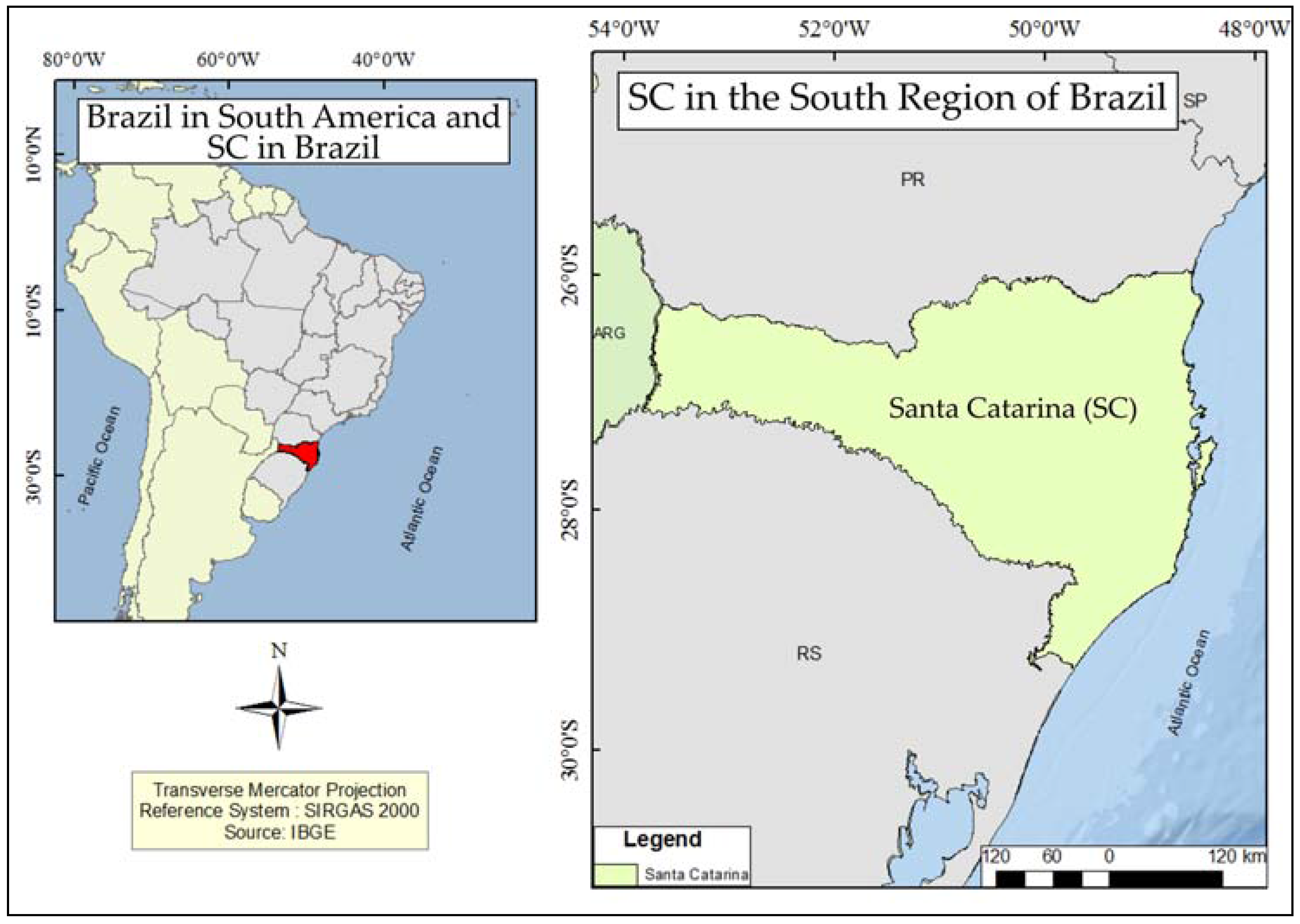
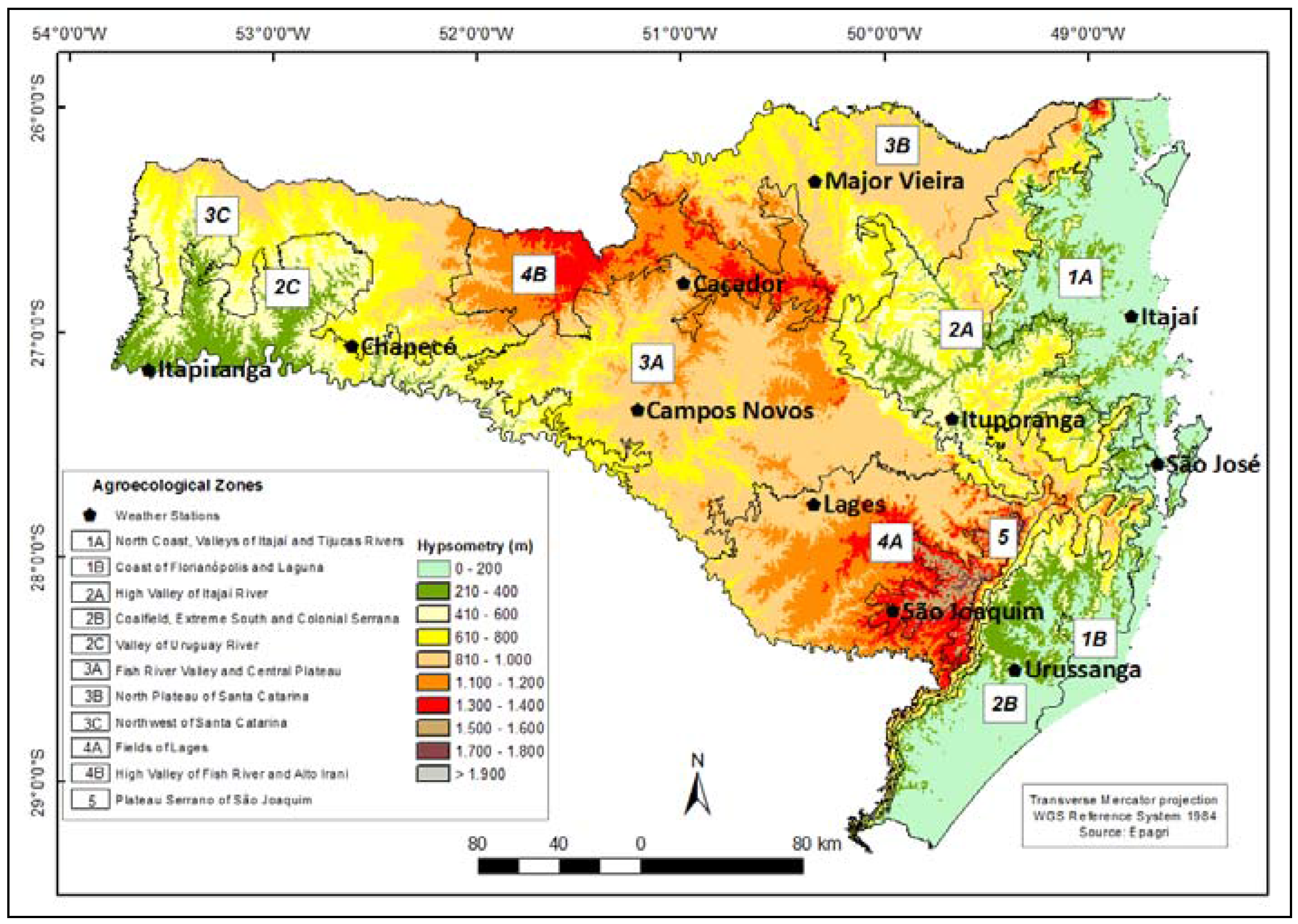
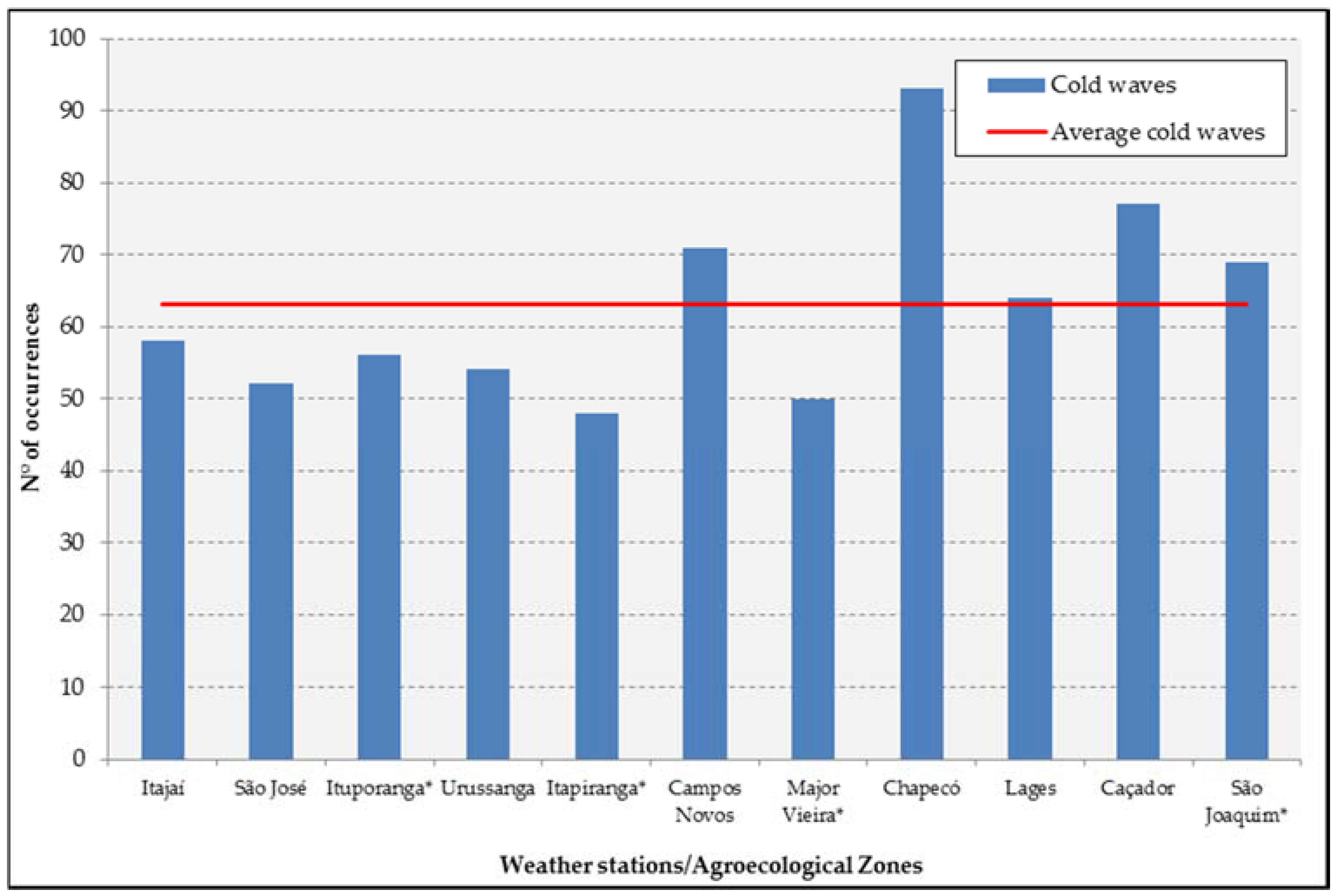
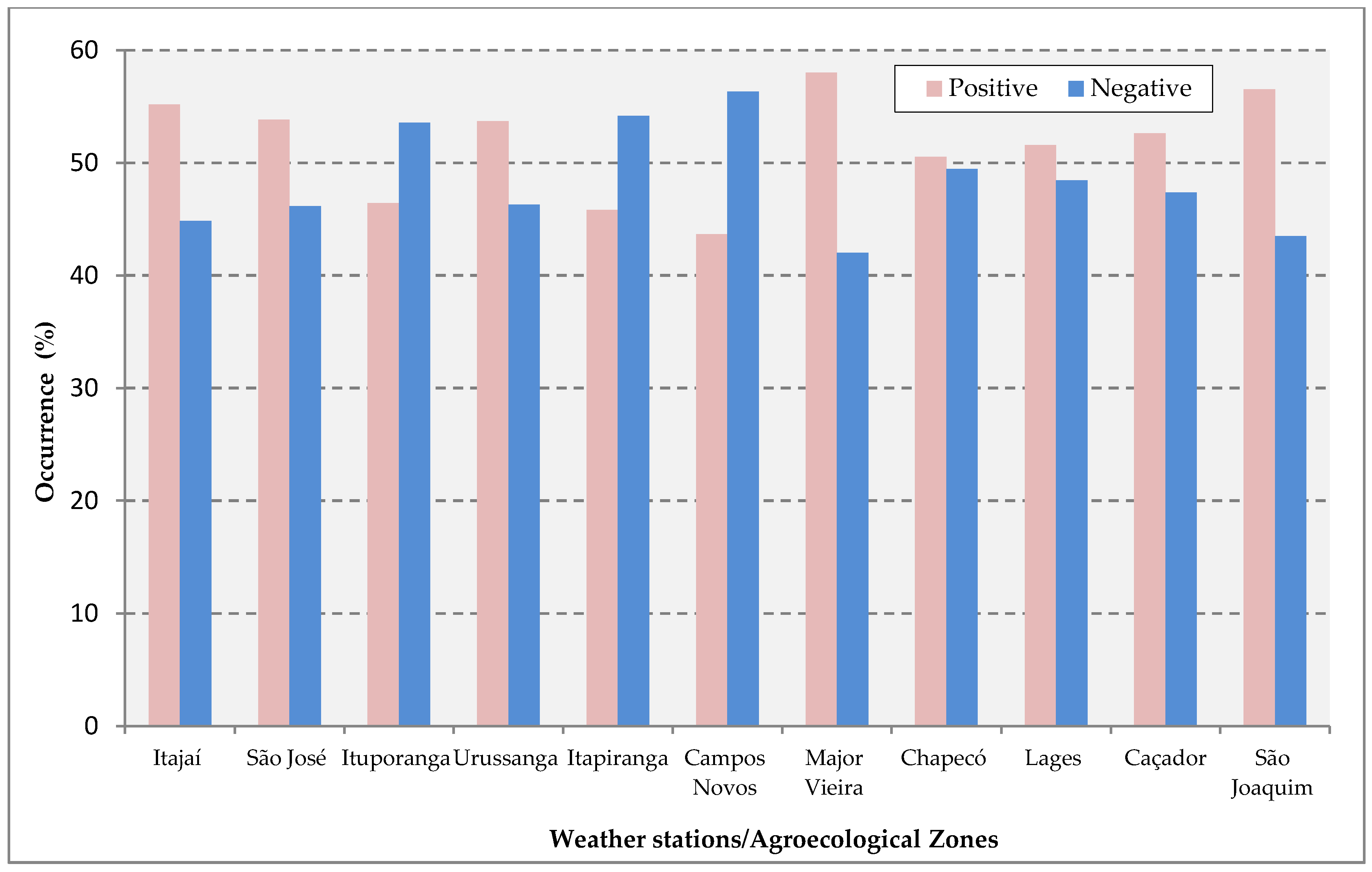
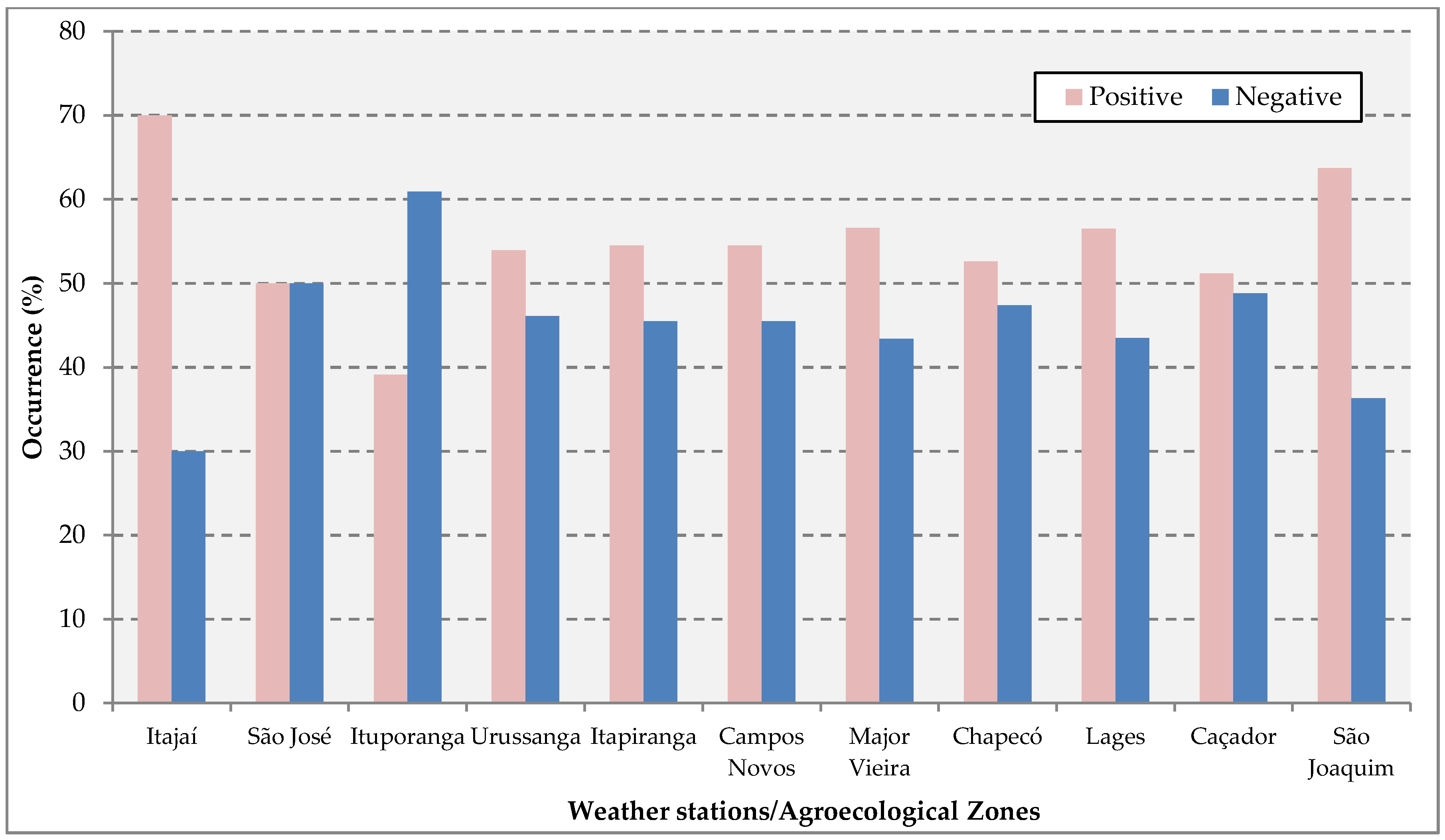
| YEAR | January | February | March | April | May | June | July | August | September | October | November | December |
|---|---|---|---|---|---|---|---|---|---|---|---|---|
| 1983 | −1.340 | −1.081 | 0.166 | 0.149 | −0.437 | −0.263 | 1.114 | 0.792 | −0.696 | 1.193 | 0.727 | 0.475 |
| 1984 | −1.098 | −0.544 | 0.251 | −0.204 | −1.237 | 0.426 | 0.890 | −0.548 | 0.327 | −0.009 | −0.024 | −1.476 |
| 1985 | −0.795 | 0.215 | −0.134 | 0.031 | −0.066 | −0.331 | 1.914 | 0.595 | 1.507 | 0.471 | 1.085 | 1.240 |
| 1986 | 0.158 | −1.588 | −0.770 | −0.087 | −1.847 | −0.619 | 0.089 | −0.157 | 0.849 | 0.306 | −0.222 | 0.886 |
| 1987 | −0.950 | −0.708 | −0.133 | −0.286 | 0.039 | −0.702 | −1.531 | 1.485 | −0.799 | 0.455 | 1.060 | 0.272 |
| 1988 | −0.612 | 0.551 | −0.219 | −0.077 | −0.749 | −1.055 | 0.576 | −0.745 | −0.689 | −2.314 | 0.401 | 1.074 |
| 1989 | 0.618 | 0.849 | 0.632 | −0.573 | 2.691 | 1.995 | 1.458 | −0.132 | −0.121 | 0.136 | 0.572 | −0.445 |
| 1990 | −0.352 | 1.151 | 0.414 | −1.879 | −1.803 | 0.093 | −1.215 | 0.466 | 1.482 | 0.139 | −0.359 | −0.312 |
| 1991 | 0.869 | −0.852 | 0.522 | −0.639 | −0.539 | −1.155 | −1.220 | 0.036 | −0.513 | −0.623 | −0.804 | −2.067 |
| 1992 | 0.073 | −1.627 | −1.010 | −0.439 | −2.032 | −2.193 | −0.566 | −0.350 | 0.435 | −0.319 | 0.122 | 0.244 |
| 1993 | −2.021 | 0.437 | −0.378 | 0.087 | 1.260 | 1.218 | 1.957 | 1.083 | 1.061 | 0.748 | 0.324 | 1.028 |
| 1994 | 0.723 | 1.157 | 0.693 | −0.052 | −0.153 | −1.682 | −0.492 | 1.910 | −0.947 | −0.578 | −0.793 | 0.933 |
| 1995 | 1.448 | 0.533 | −0.154 | 0.649 | 1.397 | −0.802 | −3.010 | −0.696 | 1.173 | −0.057 | 0.143 | 1.470 |
| 1996 | 0.332 | −0.525 | 0.543 | 0.115 | 0.983 | −0.252 | 0.021 | −1.502 | −1.314 | 0.966 | −1.667 | −0.023 |
| 1997 | 0.369 | −0.244 | 0.701 | −0.458 | 1.028 | −0.458 | 0.780 | 0.768 | 0.122 | −0.595 | −1.905 | −0.835 |
| 1998 | 0.413 | 0.390 | 0.736 | 1.927 | −0.038 | 1.031 | 1.450 | 0.904 | −0.122 | 0.400 | 0.817 | 1.435 |
| 1999 | 0.999 | 0.456 | 0.180 | 0.949 | 1.639 | −1.325 | 0.316 | 0.042 | −0.012 | 1.653 | 0.901 | 1.784 |
| 2000 | 1.273 | 0.620 | 0.133 | 0.233 | 1.127 | 0.117 | 0.059 | −0.674 | −1.853 | 0.347 | −1.537 | −1.290 |
| 2001 | −0.471 | −0.265 | −0.555 | 0.515 | −0.262 | 0.386 | −0.928 | 0.910 | 1.161 | 1.277 | 0.996 | 1.474 |
| 2002 | 0.747 | 1.334 | −1.823 | 0.165 | −2.798 | −1.112 | −0.591 | −0.099 | −0.864 | −2.564 | −0.924 | 1.308 |
| 2003 | −0.988 | −0.357 | −0.188 | 0.224 | 0.385 | −0.775 | 0.727 | 0.678 | −0.323 | −0.025 | −0.712 | −1.323 |
| 2004 | 0.807 | −1.182 | 0.432 | 0.151 | 0.460 | 1.195 | 1.474 | −0.071 | 0.254 | −0.042 | −0.242 | −0.973 |
| 2005 | −0.129 | 1.243 | 0.158 | 0.355 | −0.297 | −1.428 | −0.252 | 0.228 | 0.241 | 0.031 | −0.551 | −1.968 |
| 2006 | 0.339 | −0.211 | 0.501 | −0.169 | 1.695 | 0.438 | 0.926 | −1.727 | −0.324 | 0.879 | 0.101 | 0.638 |
| 2007 | −0.083 | 0.075 | −0.570 | −1.035 | −0.612 | −1.198 | −2.631 | −0.108 | 0.031 | −0.434 | −0.984 | 1.929 |
| 2008 | 1.208 | 1.147 | 0.587 | −0.873 | −0.490 | 1.348 | 0.320 | 0.087 | 1.386 | 1.215 | 0.920 | 1.194 |
| 2009 | 0.963 | 0.456 | 0.605 | 0.029 | −0.733 | −0.470 | −1.234 | −0.686 | −0.017 | 0.085 | −1.915 | 0.607 |
| 2010 | −0.757 | −0.775 | 0.108 | 0.377 | 1.021 | 2.071 | 2.424 | 1.510 | 0.402 | 1.335 | 1.516 | 0.205 |
| 2011 | 0.052 | 1.074 | −0.296 | −0.870 | 1.266 | −0.099 | −1.384 | −1.202 | −1.250 | 0.388 | −0.908 | 2.573 |
| 2012 | 1.583 | −0.283 | 0.275 | 0.666 | 0.153 | −0.197 | 1.259 | 0.489 | 0.562 | −0.444 | −1.701 | −0.764 |
| 2013 | 0.071 | 0.716 | 1.375 | 0.611 | 0.360 | −0.271 | 0.945 | −1.561 | −1.658 | −0.458 | 0.189 | 0.061 |
| Phase of the AAO | Weather Stations/Agroecological Zones | ||||||||||
|---|---|---|---|---|---|---|---|---|---|---|---|
| Itajaí | São José | Chapecó | Caçador | Campos Novos | São Joaquim | Ituporanga | Lages | Urussanga | Major Vieira | Itapiranga | |
| Positive | 1.88a | 1.64a | 2.76a | 2.35a | 2.06a | 2.43a | 1.73a | 1.94a | 1.70a | 2.07a | 1.57a |
| Negative | 1.85a | 1.71a | 3.28a | 2.57a | 2.85a | 2.14a | 2.14a | 2.21a | 1.78a | 1.75a | 2.00a |
| Phase of the AAO | Weather Stations/Agroecological Zones | ||||||||||
|---|---|---|---|---|---|---|---|---|---|---|---|
| Itajaí | São José | Chapecó | Caçador | Campos Novos | São Joaquim | Ituporanga | Lages | Urussanga | Major Vieira | Itapiranga | |
| Positive | 2.11a | 2.86a | 1.44a | 1.99a | 2.20a | 2.12a | 1.92a | 1.05a | 2.09a | 3.30a | 1.80a |
| Negative | 2.13a | 1.14a | 2.52a | 2.10a | 1.51a | 2.13a | 1.82a | 2.02a | 1.10a | 2.20a | 1.16a |
| Phase of the AAO | Weather Stations/Agroecological Zones | ||||||||||
|---|---|---|---|---|---|---|---|---|---|---|---|
| Itajaí | São José | Chapecó | Caçador | Campos Novos | São Joaquim | Ituporanga | Lages | Urussanga | Major Vieira | Itapiranga | |
| Positive | 0.82a | 0.52a | 2.94a | 3.70a | 3.66a | 4.93a | 1.80a | 3.58a | 2.41a | 4.28a | 1.28a |
| Negative | 0.42a | 0.64a | 3.21a | 4.28a | 3.28a | 3.21a | 3.00a | 3.35a | 2.50a | 3.83a | 1.15a |
| Phase of the AAO | Weather Stations/Agroecological Zones | ||||||||||
|---|---|---|---|---|---|---|---|---|---|---|---|
| Itajaí | São José | Chapecó | Caçador | Campos Novos | São Joaquim | Ituporanga | Lages | Urussanga | Major Vieira | Itapiranga | |
| Positive | 3.90a | 2.88a | 3.05a | 5.72a | 9.23a | 13.26a | 2.88a | 5.38a | 9.00a | 15.29a | 2.98a |
| Negative | 1.18b | 0.55b | 5.71a | 9.14a | 5.91a | 7.25a | 5.69a | 5.78a | 4.57a | 11.24a | 1.97a |
© 2017 by the authors. Licensee MDPI, Basel, Switzerland. This article is an open access article distributed under the terms and conditions of the Creative Commons Attribution (CC BY) license ( http://creativecommons.org/licenses/by/4.0/).
Share and Cite
Alves, M.P.A.; Brito Silveira, R.; Boligon Minuzzi, R.; Elvino Franke, A. The Influence of the Antarctic Oscillation (AAO) on Cold Waves and Occurrence of Frosts in the State of Santa Catarina, Brazil. Climate 2017, 5, 17. https://doi.org/10.3390/cli5010017
Alves MPA, Brito Silveira R, Boligon Minuzzi R, Elvino Franke A. The Influence of the Antarctic Oscillation (AAO) on Cold Waves and Occurrence of Frosts in the State of Santa Catarina, Brazil. Climate. 2017; 5(1):17. https://doi.org/10.3390/cli5010017
Chicago/Turabian StyleAlves, Maikon Passos A., Rafael Brito Silveira, Rosandro Boligon Minuzzi, and Alberto Elvino Franke. 2017. "The Influence of the Antarctic Oscillation (AAO) on Cold Waves and Occurrence of Frosts in the State of Santa Catarina, Brazil" Climate 5, no. 1: 17. https://doi.org/10.3390/cli5010017





